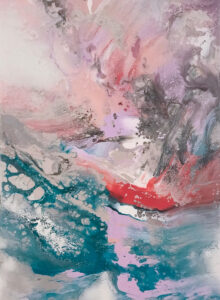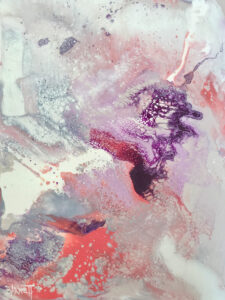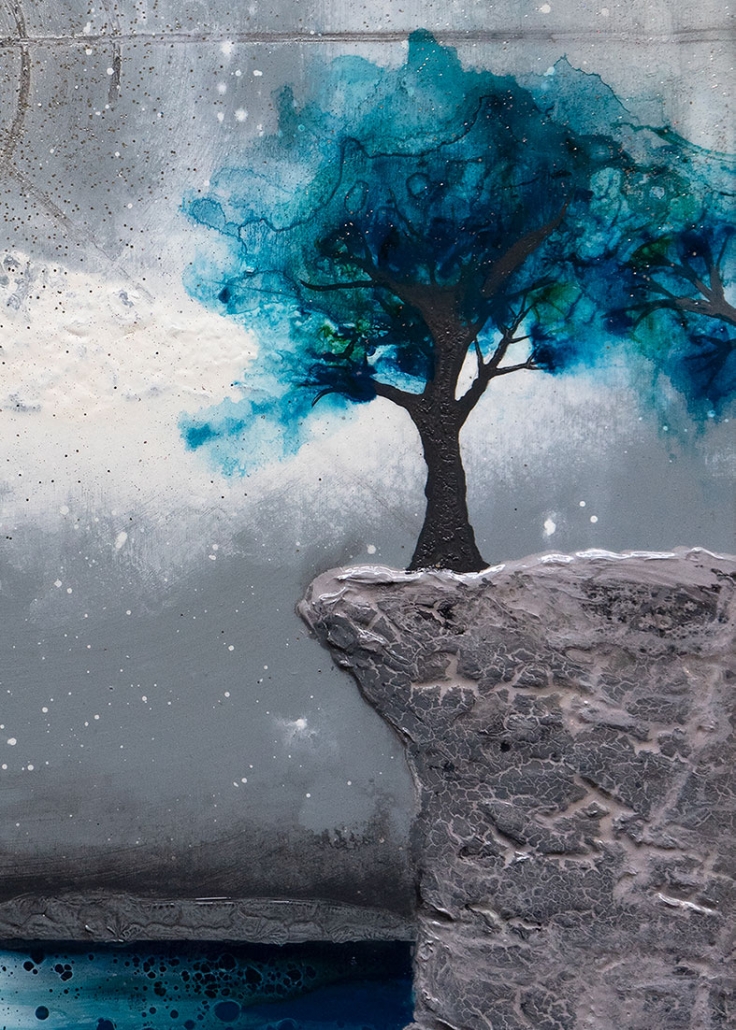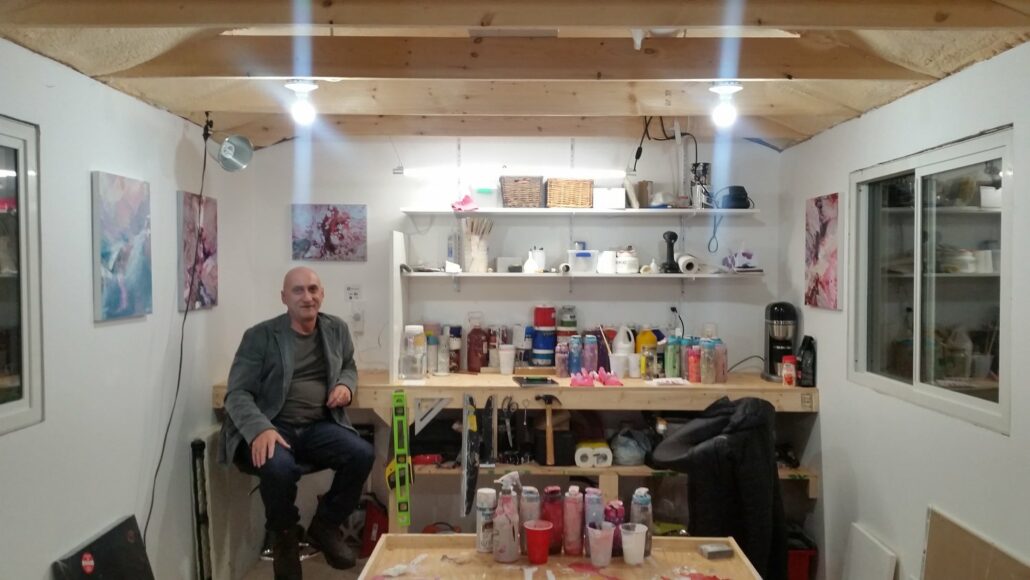In The Studio With Gary Barnett
Interview by Glodeane Brown
January 27, 2017
Gary Barnett is an artist and graphic designer. In the 1960’s after 3 years of private drumming lessons he played with several bands in the Kitchener – Waterloo area, playing a variety of styles of music from pop to rock and jazz. He later worked as a studio engineer and music producer working many local bands on independent music projects.
In the 70’s after studying graphic design and fine art, he pursued a career in abstract painting. During years of painting and showing his work in many art galleries in the Toronto, Kitchener and the surrounding area he developed a unique style of painting based on energy and nature. After working for 20 years as a graphic designer and website developer he returned to his career of painting.
By combining his experience with sound, music, and science he uses vibration, wind, chemical interactions and other nature forces to control the paint, as opposed to using brushes or other traditional painting tools. The goal is in essence to create a natural event on the canvas, in a completely organic way; much the same way that nature creates the intricate and complex patterns throughout the universe.
I’ve admired Gary’s work since I first saw it at Globe Studios spring open house in 2015. I was happy when he agreed to meet me for an interview at his home studio earlier this month.
1. You have a diverse artistic background covering music, graphic design, website development and painting. What made you want to return to painting after working for 20 years as a graphic designer and website developer?
I actually started art when I was very young, just sketching on my own and drawing. I’ve always been very interested in art. Music as well. I got involved in music very young. I took drumming lessons for about three years when I was twelve years old. I’ve been involved in a lot of aspects of art andmusic just on my own. As I got older, I went to college and took graphic design. Part of that course was life drawing and illustration. That got me more into fine art.
After the course, I decided I really wanted to get into fine art more than commercial art. I got into painting and after several years I developed my own style of painting. My style of painting was so unique at the time (and hopefully it still is), I couldn’t find a market for my art at the time. This was 30 years ago. I found it difficult to break into the art market at the time because my stuff was so different. I would approach galleries and it was a real struggle to get my paintings into the general accepted art circles. I got really frustrated and that’s when I went back to graphic design.
After being involved with graphic design for many years, the Internet came out and that just seemed to be a natural progression into web design off that. Print design, which is primarily what I did, was slowly starting to be replaced by multi media and different types of digital advertising, so I got into web design. I’ve been doing web design for about 15 years and I still do that. All the time I was involved in print design and web design, I always wanted to go back to painting. I kept saying next year, next year, and after 20 years…I finally decided you know what, this is the time. I guess it was about four years ago when I started painting again. I picked up where I left off. I took the style of painting that I developed in the early 80’s and just started to paint that same way again and develop that style more.
2. Do you think it’s necessary to have a formal education in order to be an artist?
I don’t think it is. Some of the greatest artists that we know didn’t have a formal education. I’ve read a lot of biographies of different artists, and many well known artists whose work is amazing didn’t have a formal education. I think it does help to have some basic formal training in art, not that you necessarily have to have a degree in art, but just to understand the basic fundamentals of art theory: aesthetics, colour, stuff like that. Whether or not it needs to be a formal education or not, as an artist you have to learn and develop your craft. You don’t necessarily need a formal education in order to do that. You can do that on your own, or learn from other people.
3. Who or what inspires you?
I would say there are several artists that inspire me. Jackson Pollock for one. He kind of broke the mold with abstract art. He took it to a new level. Picasso inspires me. Probably what inspires me most of all is just nature itself, and science. I’ve always been interested in different aspects of science, energy, physics. I’ve tried to apply what I’ve learned within those areas and what’s inspired me in those areas into my paintings. In my paintings I don’t use a brush, I don’t use any traditional tools that most artists use. I say that I paint with energy, using energy to control the paint.
I always go back to nature. The universe is really just chemistry and energy. That’s what the entire universe is made up of. That’s kind of the core of when I started painting and that theory has just evolved over the years. I’ve tried to apply a lot of different aspects of science into my paintings. I use a lot of different chemicals when I paint, I blow the paint, I use gravity to control the paint, heat to create a reaction, I use different chemicals to create a reaction. As well as the technique, any artist has to design their work. There still has to be a fundamental basic design and colour choices that go into it. Those always for me fall back to nature. Everything in nature has a design. If you are walking down a beach, you might see 500 shells, but there’s always that one shell that stands out and looks prettier than the rest. That’sjust because of the aesthetics of it and the colour of it. With my paintings I’m trying to create that 1 out of 500 that has that special character or look to it
4. What is your typical day like?
When I’m not making art, as I mentioned before I still work as a web designer, a little bit of graphic design. I build websites and I have a lot of clients that I’ve built up over the last 15-20 years. I’m constantly updating websites and making changes to them and building new websites. Whenever I can, I try to sneak out to my studio and get a little painting done if I have some time. Since I work for myself, it’s my own company, I have the flexibility that I can work when I want, whether that’s during the day, or the evening. Working on the website and working on my art are two different worlds. When you are working on a computer, everything has to be so precise, organized, mathematical, structural. Painting is a much more fluid, organic process. It is for me kind of an escape from my day job.
5. On average, how long does it take you to complete a piece?

It takes about an afternoon, about four to five hours. I know there’s been a lot of controversy over pricing. Some people say you should only charge this much money if it has taken you that amount of time to do it, but art doesn’t really work that way. It’s taken me 30 some years to develop this style of painting. There’s a lot of things that go into it. There’s a lot of paintings I’ve never sold, I’ve given away to people, or sometimes I’ll do a painting and I’ll get halfway through it and it’s just not working out. Because the way I paint is so natural and organic, sometimes it just won’t work out and I will just scrape it off and start over. It doesn’t take me as long as what some artists might take to complete a piece, but again, it’s not about time really, it’s about the end result. The value is what comes out of it at the end, not how long it took you to do it or how you did it.
6. What is your dream art project?
I have some new directions that I want to go in art. One in sculpturing. I took sculpture at the university many years ago. I got really interested in it but I haven’t really pursued it because it’s a whole other angle that requires a lot of time and money to get into it. My goal is to actually take my paintings and create them in a 3D world, if that makes sense? I’ve got a few ideas. I’ve done some thinking on it and I’ve done some research.
I have a direction I want to go, but right now what I’d like to do is a very large painting, like really large, 12-15 feet long by 5 or 6 feet high. I wouldn’t even be able to do it in my studio, but I do have a place that I have already talked to someone about and I can do it there, but if I’m going to do it, I would like to have it showing somewhere. I’m working on a situation where I’m looking for a place where I can put it on consignment or on loan. That would be my dream project, to do a really large painting, just because I want to do it. When I do my paintings, one of my goals is to have the person looking at it feel a lot of energy. In nature, there is a lot of explosive energy everywhere. That’s what I try to project with my paintings and I think that on a bigger scale that would emphasize that even more.
7. What has been the highlight of your career as an artist so far?
I had a show last year in Toronto at The Urban Gallery on Queen Street and that was a very successful show. I sold several pieces and had a lot of good comments about my work and I made a lot of contact and connections. I did a video interview and a lot of people saw that and commented on it. I just got back seven pieces that were in big office building in downtown Toronto, which was really good exposure for me. I will be having another show coming up soon, but the date hasn’t been set yet.
8. What’s the best art related advice you’ve been given so far?
I don’t really know if I know the answer to that. I did study art in college and at The University of Waterloo many years ago, and I did learn a lot from those courses, but I don’t know how much they helped me. I learned a lot of skills, but I think that the best things that have really helped me as an artist, I’ve learned on my own. I don’t mean to sound egocentric, but I really think that is true.
9. Do you have any advice for emerging or aspiring artists?

The best advice that I could give and probably other people have said this because I think it is pretty common sense these days, but the best advice I would give is to say true to yourself. As an artist, what really motivates you? Like most artists, when I started painting, I started with landscapes and drawing people and fruit, or whatever, but I really got bored with that. I realized after a year or two that this isn’t really what I want to do.
I started getting more and more abstract and I started studying science and finding alternative ways to paint. I did realize at that time that painting is all about control, controlling the paint; that’s basically what you are doing as an artist, whether you use a brush or a palette knife, or whatever, there are many different ways to control paint. I mean Jackson Pollock did it by dripping or throwing the paint. For me painting is all about control and I’ve always stayed true to that, even back 30 years ago when I couldn’t find galleries to show my work, I didn’t change, I always painted that way. For me, I would rather have quit painting (which I did), than try to change to do work that I didn’t feel was what I wanted to do. When I started painting again, I picked up where I left off. That’s the advice I would give any new artist. Find out what really makes you passionate, what you really like. Try new things, but when you find that thing that you know you really enjoy, that’s what you should pursue.
10. What’s next for you?
As I mentioned before, I do want to start working with 3D objects, sculpturing. That is a direction I’m slowly working towards. It’s just a matter of taking my philosophy and my concept of painting and figuring out how to work that into a 3D world. That’s a challenge. I’m going to continue to paint, my style evolves slowly and I’m always looking for new ways of controlling the paint. I’m always working on that.
Interview by Glodeane Brown Heading photo by Glodeane Brown. All other photos provided by the artist. If you liked this post, please like, comment, and share. Original Article



